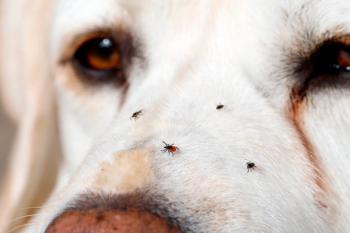
Feline fleas and flea-borne disease (Proceedings)
Vector-borne diseases have taken on increasing importance in both veterinary and human medicine as new diseases continue to become recognized and established, vector populations spread, and the potential for transmission of infectious diseases between people and pets is increasingly understood.
Controlling Vector-borne Diseases
Vector-borne diseases have taken on increasing importance in both veterinary and human medicine as new diseases continue to become recognized and established, vector populations spread, and the potential for transmission of infectious diseases between people and pets is increasingly understood. Arthropod vectors, particularly fleas, play a critical role in both creating and maintaining a source of these infections in pet cats as well as allowing transmission to cats and people. Accordingly, preventing transmission to and disease in cats and limiting the risk of zoonotic infections relies on the implementation of safe, effective flea control programs in all cats. Fortunately, highly effective flea control products are widely available. The risk of transmission of several vector-borne agents to companion animals and people further justifies advocating the routine use residual insecticides in veterinary practice.
Pathogens transmitted by fleas
Perhaps the most common and best known flea-transmitted parasitic disease of cats is Dipylidium caninum, the flea tapeworm. Cats become infected with D. caninum when they ingest an infected flea intermediate host during grooming. Although these tapeworms are not particularly pathogenic, they are aesthetically unpleasant and potentially zoonotic. Currently available D. caninum treatments such as praziquantel and epsiprantel are 100% effective in eliminating these tapeworms with a single treatment. However, cats that are treated but then returned to a flea-infested environment are almost certain to acquire infection again and will begin shedding proglottids in 2-3 weeks. Preventing post-treatment re-infection with D. caninum requires simultaneously instituting a highly-effective flea control program for all pets in the household. Because time is required for any flea control program to eliminate a home infestation, a second dose of cestocidal treatment is usually dispensed with instructions to re-administer in two weeks time. This second treatment targets the additional tapeworms that will likely be acquired from the environment while the client also works to control the flea infestation.
Another common infection of cats that fleas are central to maintaining is Bartonella henselae, the causative agent of cat scratch disease. Fleas transmit B. henselae from infected to naïve cats, and kittens are particularly susceptible to developing high levels of bacteremia. Although B. henselae infections are usually not symptomatic in cats, when the organism is transmitted to a person through a bite or a scratch wound, severe, febrile disease associated with lymphadenopathy and general malaise can result. Preventing B. henselae infection in cats and subsequent transmission to people requires placing all kittens and cats on routine, effective, year-round flea control programs. Because kittens are prone to both developing bacteremia and inflicting the minor bites and scratches that allows transmission to people, flea control should be instituted in all kittens at the earliest possible opportunity.
Rickettsia felis is a relatively new species of pathogenic rickettsia isolated from Ctenocephalides felis fleas. An obligate intracellular organism, R. felis is a member of the spotted fever group rickettsia and has been identified in patients that were originally diagnosed with murine typhus. Because it is passed through fleas transovarially, a population of fleas may harbor the bacteria for generations. When bacteria are deposited near the bite wound of the flea, infection can result and may lead to development of a febrile syndrome in people characterized by rash, headache, vomiting, and profound lethargy. Because fleas are considered both vector and primary reservoir, keeping cats flea-free is key to preventing disease in people.
Zoonotic implications of flea-borne pathogens
Fleas readily feed on people creating bite wounds and associated secondary excoriations. In addition, ectoparasite infestations on cats may increase the risk of transmission of zoonotic infections to people. For example, Dipylidium caninum (see above) may infect young children who inadvertently ingest a flea from the environment (Molina et al., 2003). Although not a serious pathogen, D. caninum infections can be very unsettling to parents.
More serious flea-transmitted pathogens include Bartonella henselae (see above), the causative agent of cat scratch disease, which is transmitted between cats via flea bites, and Rickettsia felis (see above), a recently identified spotted fever group Rickettsia spp. People acquire B. henselae infection via a bite or scratch from an infected cat, most often a kitten. The resultant cat scratch disease may present as lymphadenopathy, fever, malaise, cutaneous angiomatosis, endocarditis, and/or osteomyelitis; the initial entry wound often persists as an eschar. Antibiotic treatment may be indicated in cases where infection is not confined to the lymph nodes or is prolonged (Chomel et al., 2006); although some cases can be refractory to treatment, most acute cat scratch disease resolves spontaneously. Although less well understood, Rickettsia felis infection of people can also result in a febrile disease similar to those caused by other spotted fever group rickettsia (Reif and Macaluso, 2009).
Prevention of Dipylidium caninum infection, cat scratch disease, and flea-associated rickettsiosis in people requires strict adherence to highly-effective flea control programs to minimize the risk that pets will be infected with these pathogens or the vectors that transmit them. Additional control measures include keeping cats indoors to prevent both flea infestations and direct transmission of B. henselae from other cats and encouraging adult cats rather than kittens as pets, particularly for immunocompromised clients or those with young children. Older cats are thought to be lower risk because they are both less likely to be bacteremic and less likely to engage in rough play behavior that may result in frequent bites and scratches (Chomel et al., 2006).
Preventing infection with flea-borne pathogens in cats and people
Cats and people develop disease from many of the same flea-borne pathogens. The most common source of fleas to both people and pets is thought to be contact with recently emerged stages in an infested environment rather than direct contact with infested dogs and cats. Nonetheless, keeping cats on effective insecticides year-round helps to decrease the population of fleas within the cats' home range, and thus decreases the overall number of fleas to which both pets and people are exposed. In addition to the routine monthly use of insecticides, habitat modifications can greatly impact flea populations in the environment. For example, replacing carpets with more easily cleaned hard floor surfaces such as tile or wood can reduce environmental burdens of immature fleas indoors. Keeping shrubs and grass closely clipped and installing fences to exclude wildlife from the back yard may also aid in reducing outdoor flea populations. With strict adherence to the routine use of flea control products on cats, the risk of infection with flea-borne disease agents in both pets and people can be greatly reduced.
Selected references (additional specific references available upon request)
Chomel BB, Boulouis HJ, Maruyama S, Breitschwerdt EB. 2006. Bartonella spp. in pets and effect on human health. Emerg Infect Dis. 12(3):389-94.
Molina CP, Ogburn J, Adegboyega P. 2003. Infection by Dipylidium caninum in an infant. Arch Pathol Lab Med. Mar;127(3):e157-9.
Reif KE, Macaluso KR. 2009. Ecology of Rickettsia felis: a review. J Med Entomol. 46(4):723-36.
Newsletter
From exam room tips to practice management insights, get trusted veterinary news delivered straight to your inbox—subscribe to dvm360.






